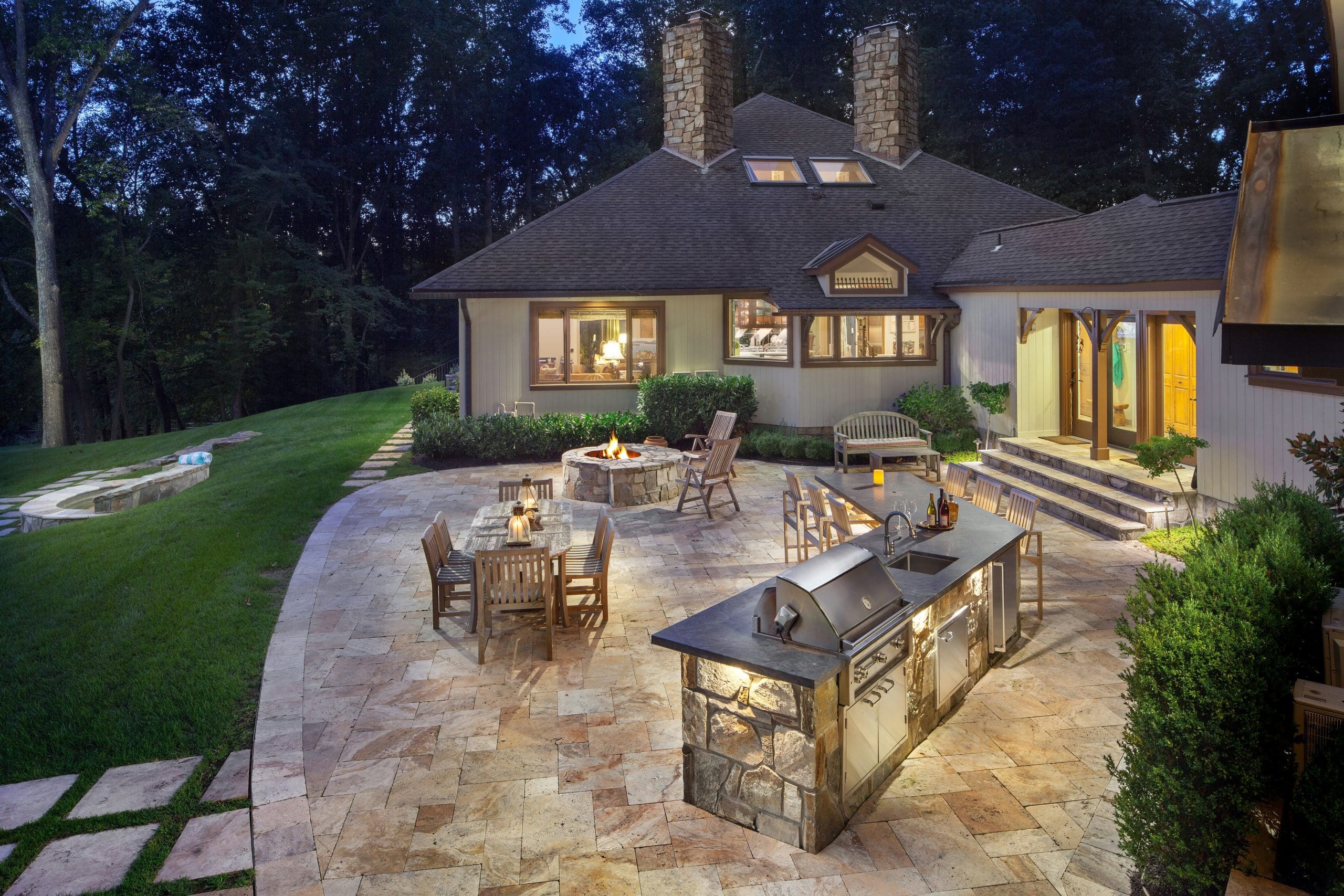
What does it take to be truly innovative in hardscaping? It can be easy to fall into a pattern of using the same materials and building the same design for client after client. But innovation and true out-of-the-box thinking can set one landscape design apart from the rest.
When it comes to creativity, every single detail matters, says Jeff Rossen, owner of Rossen Landscape in Great Falls, Virginia. Rossen says that nothing about their projects is cookie-cutter.
“We keep everything high-quality by paying attention to the seemingly small details, which really aren’t small at all,” he says. “For instance, we don’t just end a retaining wall at a 90-degree corner. We might add a stone column or a hand-selected specimen boulder with moss growing on it. We might also curve the corner to ensure it flows with the rest of the landscape. The last thing we want is a random corner sitting in the middle of a landscape — it must all flow. How we achieve that is going to be different on every project.”
Michael Pasquarello, a landscape architect with Elite Landscaping in Berlin, New Jersey, says that landscape designers can fall into a rut of producing the same cookie-cutter designs again and again because it’s easy.
“But every project should be approached as if you were going to be judged for an award,” he says. “Most properties are unique in some sort of way so if your design strategy complements the relationship to the property, then it too should be unique in its own way.”
Where to Start?

Of course, designers are always challenged to work within certain confines while still allowing their creativity to flourish. The client’s ideas, wants, and needs — as well as their budget — may feel restrictive but can actually be a starting point for out-of-the-box thinking.
“When clients show us pictures of spaces they like, we use them as tools to drive the concept of the design while still leaving plenty of room to honor their particular space and give them something special,” says Claire Goldman, principal and head of design and business development for R&R Landscaping in Auburn, Alabama. “To me, honoring a space means appropriately working within the confines of the area. We want to complement the architecture of the home and treat each property with respect in regard to water flow, special views, trees, and other natural objectives we plan to incorporate. The exterior and the interior should flow together, not compete with one another.”
Mason Shaffer, garden designer with Blanchford Landscape Group in Bozeman, Montana, says that his design process definitely begins with respecting the site conditions as well as the architecture of the home — and then blending the client’s wants/needs with those two elements. He also thinks about “experience, first,” he says.
“I’m sure a lot of landscape contractors are focused on selling as much hardscaping as possible, but I’d rather design for purpose, first,” he says. “I’ll put the furniture on the plan first and then design a patio for size and scale to make sure there’s enough room to walk, a good flow, and the space to accomplish what the client wants out of the space. Hardscaping is the most expensive piece of the plan, so it must bring a lot of value while also being respectful of the client’s budget.”
In terms of harnessing creativity, Shaffer says that he loves to work on a property with various elevations. While many landscape contractors view a sloped property as a challenge, Shaffer sees it as an opportunity.
“Some of my favorite projects have been those with spaces separated by elevation,” he says. “It allows us to add stairs built from natural stone and creates a much more dramatic effect of having these different ‘rooms.’”
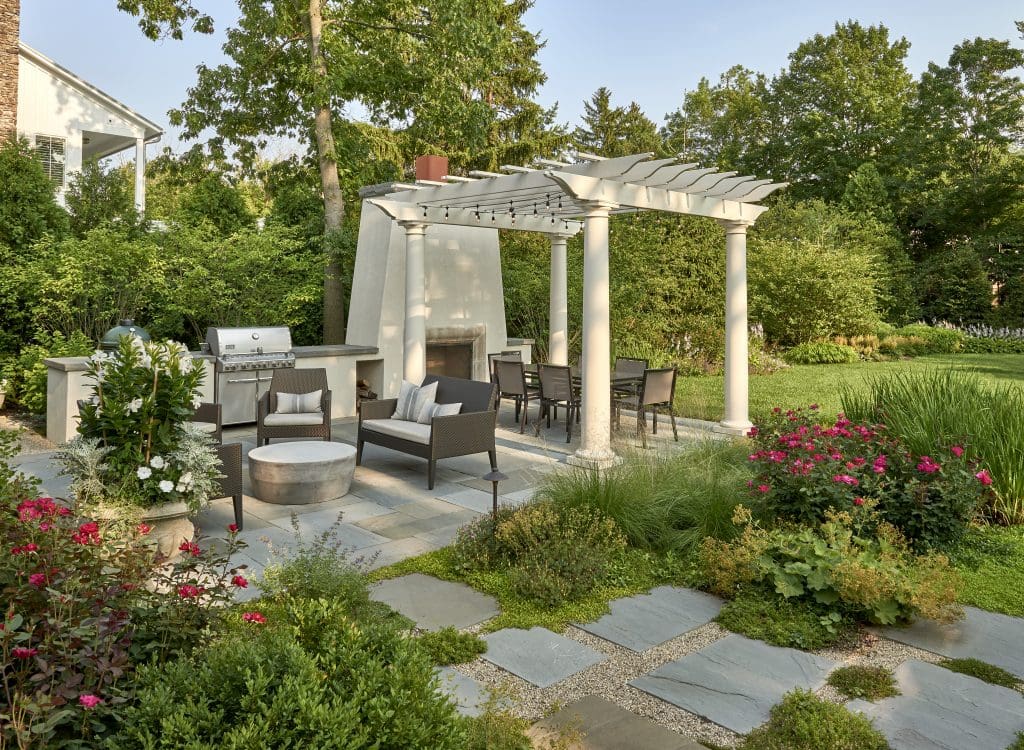
Carrie Woleben-Meade, PLA, design principal with Mariani Landscape, headquartered in Lake Bluff, Illinois, agrees that a slope can be an advantage to create something truly unique.
“Instead of one, expansive patio, a grade change can help to naturally break up the design with dynamic interest,” she says. “It gives you the opportunity to create different rooms for different purposes. Perhaps one is an entertaining space, and one is a lounge space.”
Like Shaffer, Woleben-Meade says that hardscaping creativity must be able to work within the confines of the budget. But it comes down to an outside-of-the-box thought process. Not every element of the project has to be custom, she explains.
“I’ve been starting to integrate some different techniques such as using a lot of steel for risers — something that would free up some dollars to do something really cool with the patio,” Woleben-Meade explains. “A lot of it is thinking about where to spend on custom details. If I can figure out a less expensive way to build a step, then maybe I can do a really cool granite border around the patio. It becomes a matter of prioritizing where those custom details matter most.”
Woleben-Meade says that in many ways, creativity becomes a differentiator for top-tier landscaping companies — and justification for clients to pay more for their work.
“Clients are spending a lot with us, so they certainly don’t want the same patio or walkway design that their neighbor has,” she adds. “It comes down to how we differentiate ourselves as designers so that it is truly original every single time.”
When it comes to ensuring originality on every project, Nick Onesto, landscape designer with Goldberg and Rodler, Inc., in Huntington, New York, says that each project must truly start from scratch — with an entirely fresh perspective.
“In looking at this from the design perspective, we are taking a holistic approach to every single project that we do,” he says. “In design, I am influenced by site conditions and by the client’s goals — and how we can use all the tools in our designer toolbox to create something entirely unique and true to the site.”
Beyond the Patio
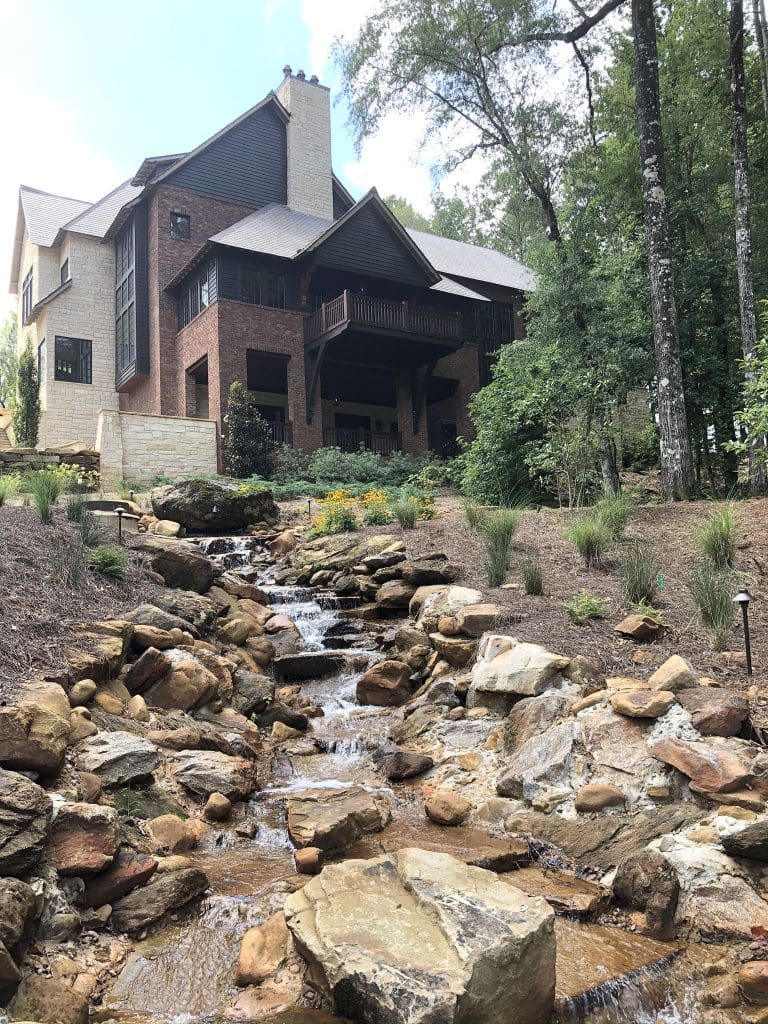
It’s so easy to think of hardscaping in terms of patios, and that usually is the showpiece of many outdoor living projects. But hardscaped projects may also include walkways, retaining walls, and fire features like fire pits and outdoor fireplaces. Even the selection of boulders or rock used as decorative accents are opportunities for creativity.
Woleben-Meade says that walkways are an important hardscaping element as they are what add curb appeal to the front of a home. When all residential designs in a neighborhood begin to look identical, walkways can be the element that makes a home unique. Of course, she says, this is no small feat. After all, how many different ways can you really walk from the driveway to the front door? More than you may realize when you start to think out of the box, she says.
“Walkways must first and foremost be functional,” she says. “Walkways ultimately come down to serving a purpose of taking someone from point A to point B. But we must think about how we can make it feel like something different and unique about this house? Is it a landing area with a bench? Is it a pattern on the border? There are more design ideas beyond just a simple path that can make curb appeal unique and help the client to take pride in their property.”
Materials Matter
There’s no question that the chosen materials also contribute to a project’s creativity.
Rossen says that they’re “thinking out of the box” by not limiting their selection to only what’s available locally.
“I’ll fly to Tennessee to the mountains so that I can hand-select the boulders and a lot of the stone we’re using in these projects — and then have them shipped back to us,” Rossen says.
Woleben-Meade says that one of the first steps to creative design is not feeling “tied to what you have in inventory or what’s in your yard.”
“We try to think outside of the box as much as we can with material,” she says. “Of course, here in Illinois where we have some intense freeze/thaw cycles, we are limited by the climate. We have bluestone and limestone that both work really well — but how can we use them differently in order to be creative? We do a lot with patterns and finishes and layout. For instance, I might do a border with a slightly different finish — and then change the pattern on the interior. I have used bluestone on an edge in thin pieces for a herringbone pattern. It doesn’t always have to be the whole patio. A typical patio with a unique patterned border can be just the spark that project needs to be entirely unique.”
Goldman says that materials can absolutely play a role in creativity. One of her favorite spaces is a recycled concrete patio.
“It’s almost more satisfying to repurpose an old material in a new way than it is to find a new material that we love,” she says. “The client on this project was someone who sought to be a responsible consumer and aims to make sustainable choices whenever possible. We salvaged a pile of old concrete from a recent driveway removal and installed it in a new way with polymeric sand in the joints for a unique patio vibe that suited this family and reflected their values in the landscape.”
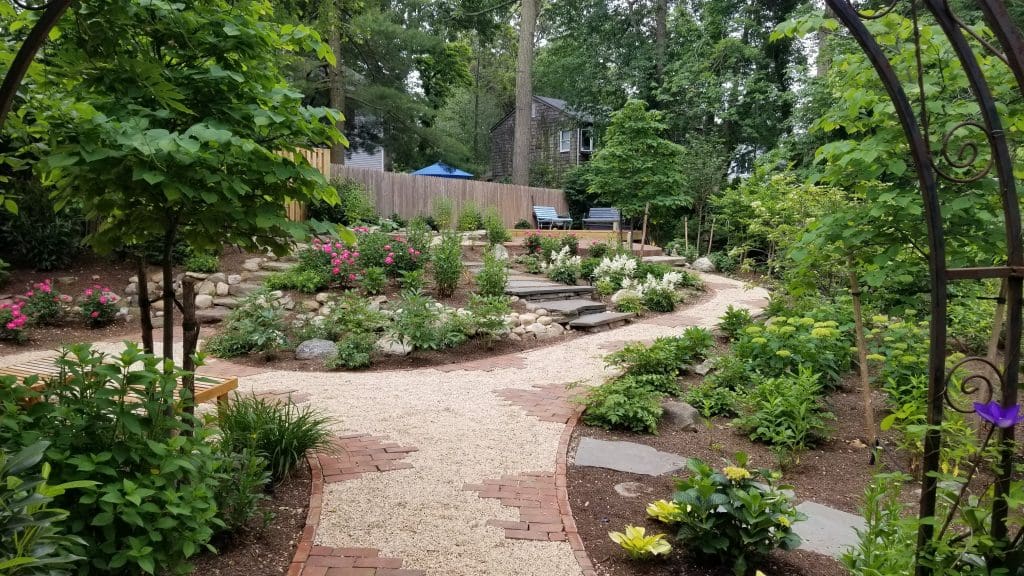
Onesto also recalls a project in which a unique material choice lent itself to fitting the unique objectives. This project, “The Secret Garden,” was an area on the client’s property where she had a writing cottage. She wanted a rustic pathway leading to the cottage that would look like it had been there a hundred years.
“I definitely had to think outside of the box on this one,” Onesto recalls. “It was 2019 but I had to think about how I could bring in materials that looked like they were from 1919. I designed a brick walkway and then started deleting sections of the brick, creating these voids in the pathway that we filled with pea gravel. It starts out as a nice landing with the bricks all connected, but as you follow the path, the bricks appear as though they break away. We also have strategic plantings on either side. It looks incredibly rustic for being new construction.”
Like Goldman’s project, Onesto says this utilized recycled materials.
“We had the bricks from an old retaining wall we had taken apart on a different project,” he explains. “They were perfect for this project. Had we used brand-new bricks, it just would not have fit. Instead, these bricks had some natural cracking and chipping — which was just what my client wanted in this case. Something that evoked a feeling of being old and rustic as though it had been there all this time.”
In general, site conditions can certainly dictate which materials might work best. Shaffer has a preference to using natural stone, which inherently lends itself to originality. In the Bozeman, Montana area, natural stone just looks like it belongs.
“With natural stone, every piece is one-of-a-kind,” he says. “It’s also a timeless material that will never go out of style. When we use a regional stone, it helps the design to fit into the natural landscape, which is always our goal. We want the natural surroundings to blend seamlessly with what we design.”
Inspired to be Different
While it can be the path of least resistance to build the same types of hardscaping projects over and over — particularly if they’ve been successful — going against the flow with highly creative thinking can help raise the bar for landscape design.
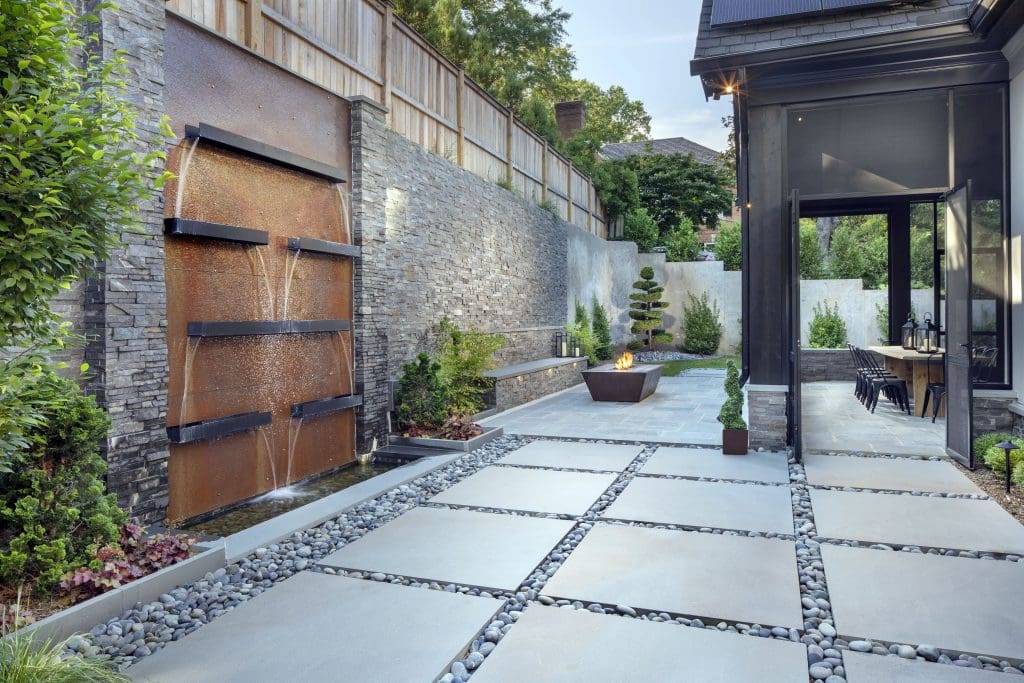
Rossen says that he continues to evolve creatively and push the envelope with his natural stonescapes as a result of trying to emulate two of his mentors and friends, Barry Schneider and Steve Coffey — both of whom have inspired him to create one-of-a-kind pieces of living art — the kind of projects you’ll never see somewhere else again.
At the end of the day, Rossen says it comes down to making people happy — and that’s where so much of his creative drive comes from.
“My job is to create environments that make people happy,” he says. “To do that, we need to create something truly unique — that becomes entirely their own. Our clients hire us for that creativity and because they know when we’re finished with their project, it will be unlike any other out there.”
This article was published in the May/June issue of the magazine. To read more stories from The Landscape Professional magazine, click here to subscribe to the digital edition.

